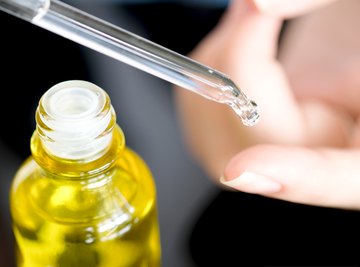
Melanin is a dark, naturally occurring pigment that comes in several forms and is responsible for much of skin color in humans. It is produced by cells called melanocytes, which sit in the deepest part of the outermost layer of skin. Much of this melanin finds its way into cells called keratinocytes, which are far more numerous than melanocytes.
After melanin is synthesized, it is stored in bodies within melanocytes called melanosomes. The most common of the various types of melanin is called eumelanin, which means "good melanin." When lots of eumelanin is present in higher quantities, a darker, more brown skin color results, whereas a low density of this pigment occurs in people with lighter skin.
When people show differences in skin color resulting mainly from differences in skin melanin content, this is not because people differ widely in terms of the number of melanocytes they have. Instead, some people's individual melanocytes are far more active then they are in others.
Melanin Chemical Structure
Like many substances in the body, the chemical makeup of melanin includes a mixture of carbon, hydrogen, oxygen and nitrogen. The melanin chemical formula is C18H10N2O4, giving melanin a molecular weight, or molar mass, of 318 grams per mole (g/mol).
(For historical reasons, a mole is the amount of a substance in grams that contains 6 x 10 23 molecules, and is a basic measure of a molecule's size.)
Melanin consists of three six-membered rings (six atoms arranged around a central point) in a line, each with a five-membered ring nestled in one of the angles between itself and its neighbor. These five-membered rings each contain one of the two nitrogen atoms in melanin, and sit on opposite sides of the molecule.
The four oxygen atoms in melanin are bound to carbons on the six-atom ring at each end, two to each ring. These are double bonded, and the C=O arrangements lie on opposite sides of the ring from where the five-membered rings are attached.
Alternative Melanin Chemical Formula
If you wished to express the formula for melanin in a more explicit form without resorting to drawing a model, you could write it in the form used in the Simplified Molecular-Input Line-Entry System (SMILES):
CC1=C2C3=C(C4=CNC5=C(C(=O)C(=O)C(=C45)C3=CN2)C)C(=O)C1=O
where the numbers are not subscripts but references to the numerical positions of atoms within individual rings. Hydrogen atoms in melanin are not included but their number and positions can be determined by filling in any "gaps" in the above structure, keeping in mind that each carbon forms four bonds.
Basics of Skin Color
Human skin has three layers, which from outermost to innermost are the epidermis, the dermis and the subcutaneous tissue layer. The epidermis is itself divided into numerous layers, the deepest of which is called the stratum germinativum (sometimes called the stratum basale). This layer, which adjoins the basement membrane separating the epidermis from the dermis, is where melanocytes are produced.
On microscopy, melanocytes have a characteristic irregular shape. The extent to which melanocytes produce melanin depends on the extent to which the gene for melanin is expressed, or turned on. Think of "gene expression" as turning on a switch at a factory to make a particular product, in this case a protein.
Almost all human beings have plenty of melanin "factories" (melanocytes), but the extent to which people put these "factories" to use varies widely between both individuals and ethnic populations.
Other Factors in Skin Color
Sunlight triggers melanin production to some extent in most people; this is the process of short-term skin darkening known as a "tan." The melanin produced by light stimulus acts to shield the rest of the body to some extent from harmful ultraviolet (UV) radiation in sunlight.
When the body no longer senses an abundance of UV rays in the environment, as occurs in the fall and winter, the perceived need for melanin production decreases as well and the skin tends to lighten during these seasons.
Also, while melanocytes manufacture melanin as well as store it and release it, the far more prevalent epidermal cells known as keratinocytes wind up as the greatest recipient of the pigment. The movement of melanin from melanocytes to keratinocytes is facilitated by the many tentacles (up to 40 or so) extending outward from each melanocyte.
Melanosomes formed in melanocytes travel to the keratinocytes and position themselves between the cell membrane and the nucleus, helping to shield the DNA (deoxyribonucleic acid, the "genetic material" of humans and all known life forms) within that nucleus from UV radiation damage.
Types of Melanin
While eumelanin is the most abundant type of melanin produced by humans, it is far from the only common type. It exists in two other main forms, pheomelanin and neuromelanin. Eumelanin and pheomelanin have a great deal in common functionally and chemically, whereas neuromelanin is something of a rogue.
Eumelanin and pheomelanin are both made by melanocytes in the lowest stratum (layer) of the epidermis. These cells begin as melanoblasts in tissue that is derived from the neural tube during human embryonic development. The synthesis of each of these starts with tyrosine, a molecule closely related to the amino acid phenylalanine. The tyrosine is soon converted to dopaquinone, which can follow a number of different chemical pathways that ultimately result in melanin production.
Neuromelanin is produced in the brain as part of the decomposition of the neurotransmitter dopamine, another close chemical relative of phenylalanine and tyrosine. This occurs in a part of the brain called the substantia nigra. Neuromelanin, unlike the other two forms of human melanin, is not a participant in the determination of skin color.
The Functions of Melanin
Melanin's claim to biological fame is its contribution to skin color, but it performs a number of related and unrelated physiological functions as well. Melanin influences hair color and it also protects the skin and the eyes from light damage from the sun and other sources of electromagnetic radiation.
Eumelanin is more brownish-black in color, whereas pheomelanin is more yellowish-red. The over color of a person's skin is determined by a combination of the ratio of these two types of melanin and the overall density of melanosomes within individual cells.
Also, different types of melanin predominate in different parts of the body in the same individual. For example, the lips, which are more pink, are higher in pheomelanin.
Skin that is lighter in color typically has a density of two or three melanosomes per cluster within the melanocytes, whereas darker skin features more "mobile" melanocytes in that these granules are more inclined to spread to neighboring keratinocytes.
Melanin and UV Protection
At some point in human evolution, different populations of individuals settled far from one another, with some remaining closer to the equator and others venturing toward northern latitudes, mostly in Europe at first. As a consequence of being in a sunnier and hotter environment, people closer to the equator lost much of their body hair in relation to their more northerly-ranging counterparts.
It is this change in relative hair distribution that is believed to have spurred the differential development of melanogenesis in different populations worldwide. People living closer to the equator now demonstrate a higher ratio of eumelanin to pheomelanin, resulting not only in darker skin but in a greater capacity to absorb UV radiation. People living in cooler areas with less sunlight, on the other hand, show a lower ratio of eumelanin to pheomelanin, and consequently are more susceptible to UV skin damage, including cancer.
In 2015, researchers at Yale University reported that they had found a way in which UV light reacts in melanin in mice in a manner that promotes cancer formation in a matter of hours. This seemed to highlight the exquisitely "two-edged" nature of melanin. For every area in which it can serve as a health asset, it seems to present a health liability somewhere else.
Other Physiological Roles of Melanin
Vitamin D, which is important in the body's handling of the mineral calcium, must be subject to UV light in order to be converted to its active form after it is ingested. This means that people living at northern latitudes generally are more susceptible to vitamin D deficiency, because their bodies on average receive less sunlight throughout the year than people nearer to the equator do.
Another implication of the relationship between UV light and melanin, however, is that darker-skinned people, no matter where they live (but especially those in very northern or southern locations), should be monitored for problems with vitamin D levels, because their high density of melanosomes, while conferring protection against the dangers of UV rays, also screens out their few beneficial effects.
A number of relationships between UV light, melanin and the behavior of the skin have yet to be fully clarified. It is known, for example, that the administration of UV light to the skin can suppress immune function in the short term. This can be desirable when trying to control flare-ups of inflammatory skin conditions with an immune component, such as psoriasis.
Whatever immune role melanin may play in the body remains to be elucidated.
Diseases Related to Melanin
A number of clinical conditions involving derangements in melanin synthesis and transport are well known. These can affect every step of the melanin-formation and melanin-distribution process.
These include:
Disorders of melanoblasts. These cells, as you may recall, are the precursors of melanocytes. They are supposed to migrate from their sites of formation in embryonic and fetal development to the places where they will ultimately play their assigned roles.
However, sometimes melanoblasts fail to make it to where they are supposed to go. One result is Waardenburg syndrome, in which affected people have areas of very light skin and prematurely gray hair owing to failure of melanoblasts to take up residence in these areas earlier in life.
Disorders of melanocytes. Among the more notorious of these is the condition called vitiligo, which involves the autoimmune-mediated destruction of melanocytes in a non-uniform way throughout the skin.
Because of the asymmetrical way in which the body attacks its own cells, the skin shows distinct patches of light skin intermingled with unaffected areas of skin.
Disorders of melanosomes. Two of the more common disorders involving the storage sites of melanin are Chédiak-Higashi syndrome and Griscelli syndrome, both of which involve visible skin pigmentation issues but also include effects in other body systems as well.
In Chédiak-Higashi syndrome, which can produce albinism (a near-total lack of pigmentation in the skin and eyes), it is believed that the gene mutation responsible for the melanin component of the disorder also prevents the synthesis of important immune-system chemicals.
Disorders related to tyrosinase. Tyrosinase is the enzyme, or biological catalyst protein, that converts an intermediate compound in melanin and pheomelanin synthesis, called dihydroxyphenylalanine, into dopaquinone. When this enzyme fails to work properly or is absent, the melanin synthetic pathway can be disrupted.
For example, in the hereditary disease phenylketonuria (PKU), the failure of a different enzyme leads to a significant buildup of phenylalanine, which has secondary, inhibitory effects on tyrosinase. This leads to patchy skin thanks to a "downstream" decrease in melanin synthesis.
References
About the Author
Kevin Beck holds a bachelor's degree in physics with minors in math and chemistry from the University of Vermont. Formerly with ScienceBlogs.com and the editor of "Run Strong," he has written for Runner's World, Men's Fitness, Competitor, and a variety of other publications. More about Kevin and links to his professional work can be found at www.kemibe.com.
